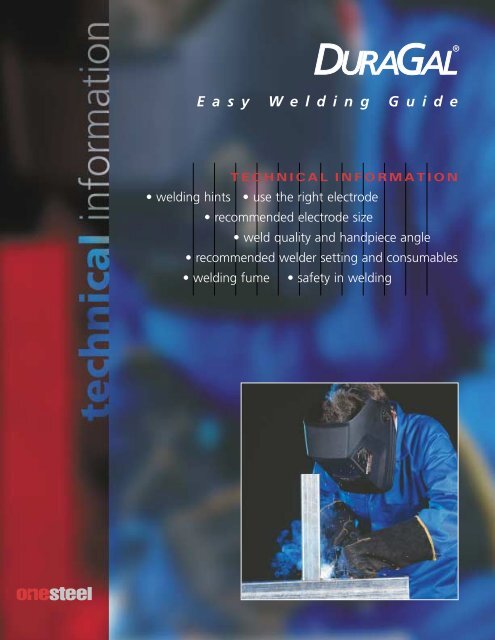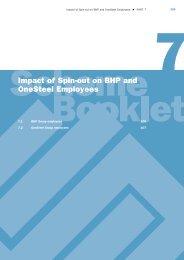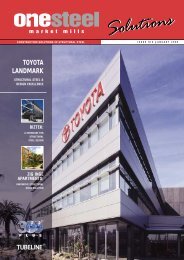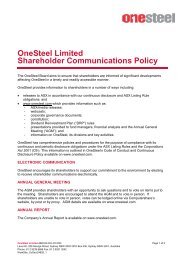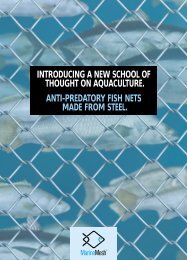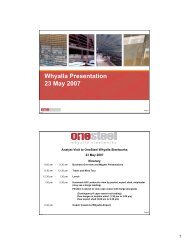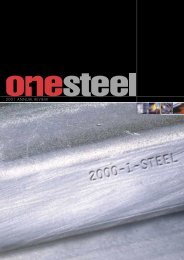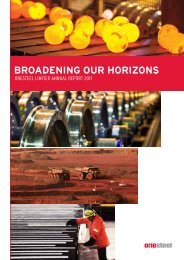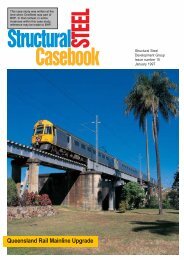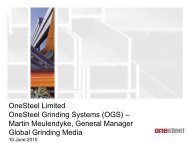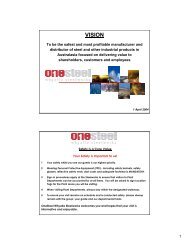easy welding - OneSteel
easy welding - OneSteel
easy welding - OneSteel
You also want an ePaper? Increase the reach of your titles
YUMPU automatically turns print PDFs into web optimized ePapers that Google loves.
E a s y W e l d i n g G u i d e<br />
TECHNICAL INFORMATION<br />
• <strong>welding</strong> hints • use the right electrode<br />
• recommended electrode size<br />
• weld quality and handpiece angle<br />
• recommended welder setting and consumables<br />
• <strong>welding</strong> fume • safety in <strong>welding</strong>
TECHNICAL INFORMATION<br />
THE FAMILY OF DURAGAL PRODUCTS ®<br />
This guide applies to <strong>welding</strong> techniques for low carbon steel used in The Family of DuraGal Products ® .<br />
(maximum carbon equivalent 0.39.)<br />
These sections, with their lustrous, thin, evenly applied zinc coating can be as readily welded as black steel.<br />
Using this guide will assist in achieving the best possible appearance and the highest quality welds with<br />
the minimum of spatter and fuming.<br />
INDEX<br />
PAGE<br />
GLOSSARY OF TERMS 3<br />
WELDING HINTS<br />
Preparing Joints in Rectangular and Square Hollow Sections 3<br />
Preparing Joints in Circular Hollow Sections 4<br />
USE THE RIGHT ELECTRODE<br />
Shielded Metal Arc Welding (Stick) 4<br />
HANDPIECE ANGLE<br />
When MIG Welding, Handpiece Angle 5<br />
RECOMMENDED WELDER SETTINGS AND CONSUMABLES<br />
Shielded Metal Arc Welding (Stick) 6<br />
Gas Metal Arc Welding Short Arc 7<br />
Flux Cored Arc Welding 8<br />
WELDING FUME 9<br />
SAFETY IN WELDING 9<br />
PAGE 2
<strong>easy</strong> <strong>welding</strong> guide<br />
GLOSSARY OF TERMS<br />
CHS = Circular hollow sections (pipe).<br />
FCAW = Flux cored arc <strong>welding</strong>.<br />
GMAW = Gas metal arc <strong>welding</strong> - commonly<br />
known as MIG <strong>welding</strong>.<br />
H-fillet = Horizontal fillet - A fillet weld that has<br />
one leg on the upper side of an<br />
approximately horizontal surface<br />
and the other leg on abutting<br />
an approximately vertical surface.<br />
ILG = In-line hot dip galvanized.<br />
SMAW = Shielded metal arc <strong>welding</strong> -<br />
commonly known as stick <strong>welding</strong>.<br />
Profiles = Steel open sections, angle, channels<br />
and flats.<br />
RHS = Rectangular hollow section.<br />
SHS = Square hollow section.<br />
WIA = Welding Industries of Australia.<br />
WTIA = Welding Technology Institute of<br />
Australia.<br />
The most common <strong>welding</strong> issues brought to<br />
<strong>OneSteel</strong>’s attention have been :-<br />
• "Burn through" or melting holes in the<br />
thinner wall section.<br />
• Visible ("worm holes") and internal porosity<br />
and/or unacceptable weld appearance.<br />
• Zinc vaporization (explosions) and spatter.<br />
Just a little extra care in preparation and slight<br />
changes in <strong>welding</strong> technique can help even the<br />
most inexperienced welder avoid these common<br />
<strong>welding</strong> problems.The following are some other<br />
hints that will help any welder to achieve excellent<br />
results when <strong>welding</strong> ILG hollow sections and<br />
Profiles.<br />
WELDING HINTS<br />
The thin, even coating of zinc on The Family of<br />
DuraGal Products ® means <strong>welding</strong> can be carried out<br />
safely and with minimum fuming if suitable<br />
procedures are followed.<br />
The application of a clear polymer coat to the heavy<br />
angles and channels of TThe Family of DuraGal<br />
Products ® not only improves weldability and<br />
increases weld metal deposition rates, but allows<br />
most spatter that does remain on the fabrication to<br />
be easily wiped off.<br />
DuraGal’s clean smooth coat allows instant<br />
grounding to complete the <strong>welding</strong> circuit. The thin<br />
clear polymer coating on the DuraGal ® open profiles<br />
and Ultra Fence Tubing causes minimum disruption<br />
to the grounding.<br />
We suggest you use the welder settings in this<br />
manual as a starting point and then tune the<br />
machine to suit your consumable and personal<br />
preferences.<br />
Hints<br />
• Reduced the size of the weld to a minimum.<br />
• Don’t increase the heat (to weld The Family of<br />
DuraGal Products ® ).<br />
• Preheating is unnecessary.<br />
The desired weld, smooth, even, minimum spatter<br />
Preparing joints in Rectangular and Square<br />
Hollow Sections<br />
Careful joint fit-up, with minimum gaps, has the<br />
following advantages :-<br />
• Reduced weld metal volumes.<br />
• Increased <strong>welding</strong> speeds.<br />
• Lower <strong>welding</strong> costs.<br />
• Elimination of burn through on thinner<br />
sections.<br />
• Reduced visible and internal porosity.<br />
• Less zinc burn back and thus less fuming.<br />
RHS branches welded to RHS chords of the same<br />
width require a combination butt/fillet weld to<br />
make the connection. A butt weld is used to attach<br />
the branch along the corner of the chord. For<br />
thicker section chords the larger corner radii results<br />
in a void that has to be filled with weld metal. At<br />
least two passes should be laid. Lay a small root run<br />
with the <strong>welding</strong> rod or wire aimed more at the<br />
corner of the chord than at the end of the branch.<br />
Then lay the fillet welds on the other sides of the<br />
branch. Finally lay the finishing passes on the butt<br />
welds. This procedure will minimize distortion and<br />
produce the best possible appearance at the corners.<br />
PAGE 3
TECHNICAL INFORMATION<br />
Partially flattened, and shear flattened ends are<br />
methods of achieving good joint fit-up. All three<br />
reduce the structural capacity of the CHS to some<br />
extent.<br />
If a MIG welder is to be used, increasing the root<br />
run wire stick out to 20 to 22mm (instead of the If a<br />
If a MIG welder is to be used, increasing the root<br />
run wire stick out to 0.8” to 0.9” (instead of the<br />
normal 0.6” to 0.7”) will reduce the chances of burn<br />
through.<br />
Preparing joints in Circular Hollow Sections<br />
Fully profile the branch tube to fit the mating part.<br />
This option is the most aesthetically pleasing and<br />
structurally the strongest.<br />
USE THE RIGHT ELECTRODE<br />
SHIELDED METAL ARC<br />
WELDING - STICK<br />
Specialized profiling machines can automate this<br />
joint preparation. Some CAD software can prepare<br />
paper templates for CHS joining.<br />
Most GP rods suit The Family of DuraGal Products ® ,<br />
refer to the chart on page 6.<br />
For Superior Appearance<br />
Use AWS/ASME-SFA A5:1: E6013 electrodes. This<br />
type of rod is "all positional" and will give a smooth<br />
weld with no visible porosity. The fluid slag and<br />
softer arc action<br />
of these rods allow the gases formed during<br />
<strong>welding</strong> to escape into the slag before the weld<br />
solidifies.<br />
These electrodes give welds with a minimum yield<br />
strength of 50,000 PSI and will often be suitable for<br />
<strong>welding</strong> joints in 65,000 PSI DuraGal ® fabrications<br />
because the loads to be carried are lower then the<br />
allowable capacity of the weld group. If in doubt<br />
PAGE 4
<strong>easy</strong> <strong>welding</strong> guide<br />
however it is recommended that electrode selection<br />
be in line with the required material mechanical<br />
properties (see for strength).<br />
When these electrodes cannot give a suitable joint<br />
capacity use the electrodes suggested in the next<br />
section.<br />
For Strength<br />
For strength and/or impact performance use low<br />
hydrogen electrodes.<br />
This type of rod requires the attention of a more<br />
experienced welder than the E7016 type, mentioned<br />
in the previous section, and may produce a little<br />
more spatter. Better fit up may be required.<br />
The E6013 type electrode gives a weld metal yield<br />
strength of 66,700 PSI and tensile strength of 72,500<br />
PSI.<br />
ROD DIAMETER<br />
The Recommended Rod Diameter<br />
Depends on the Thickness of the<br />
DuraGal ® Products<br />
The preferred electrode diameters are set out in<br />
"Recommended Welder Settings and Consumables".<br />
During the testing carried out in conjunction with<br />
manufacturers of electrodes to develop the<br />
recommended welder settings, 16G to 7G thick<br />
DuraGal ® products were welded using 3/32” and<br />
1/8” diameter rods at low power settings. This<br />
combination of readily available consumables and<br />
low power settings is preferred but, in the hands of<br />
an inexperienced welder of thin wall steel sections,<br />
may result in undercut which will reduce joint<br />
strength and make the slag harder to detach.<br />
HANDPIECE ANGLE (TORCH)<br />
When MIG Welding, a Handpiece<br />
Angle of 20º, is recommended<br />
Testing has shown that inclining the MIG handpiece<br />
20º with the wire pointing in the direction of travel,<br />
forehand, reduces porosity and nozzle cleaning<br />
frequency. The lateral angle should be between 40º<br />
and 50º.<br />
PAGE 5
TECHNICAL INFORMATION<br />
RECOMMENDED WELDER SETTINGS AND CONSUMABLES<br />
SHIELDED METAL ARC WELDING<br />
(STICK)<br />
Electrode<br />
Material Wall Electrode Amps Electrode Type<br />
Thickness<br />
AWS Classification<br />
Gauge (inch) inch<br />
7G (0.180) 1/8 120 E70XX<br />
13G (0.095) 3/32 85 E70XX<br />
16G (0.065) 3/32 70 E6013<br />
Manual Arc welded 2x2x0.203”<br />
DuraGal ® Angle - Lap Joint<br />
E7016 Electrode, 120 Amps.<br />
PAGE 6
<strong>easy</strong> <strong>welding</strong> guide<br />
GAS METAL ARC WELDING - MIG<br />
(DIP OR SHORT ARC)<br />
Recommended Shielding Gases<br />
Gas Type<br />
ARGOSHIELD 25C<br />
ARGOSHIELD UNIVERSAL<br />
ARCAL 211<br />
BLUESHIELD 23<br />
BLUESHIELD 8<br />
CO 2<br />
Supplier<br />
BOC GASES<br />
BOC GASES<br />
AIR LIQUIDE AMERICA CORP<br />
AIR LIQUIDE AMERICA CORP<br />
AIR LIQUIDE AMERICA CORP<br />
All suppliers<br />
Solid Electrode Wire<br />
SIZE INCHES TYPE AWS A5.18 CLASS SHIELDING GAS<br />
(ELECTRODE TYPE)*<br />
0.048 CARBON STEEL ER70S-6 ARGOSHIELD UNIVERSAL<br />
ER70S-3 ARCAL 211<br />
0.035 CARBON STEEL ER70S-6 ARGOSHIELD 25C<br />
ER70S-3 BLUESHIELD 8<br />
0.035 CARBON STEEL ER70S-6 ARGOSHIELD UNIVERSAL<br />
ER70S-3 ARCAL 211<br />
0.035 CARBON STEEL ER70S-4 CO 2<br />
* Check with supplier for 5 number electrode type for your application<br />
Settings<br />
Shielding Gas Wall Thickness Amps Volts Wire Size Wire speed Electrode<br />
G (inch) Inch ipm Type *<br />
CO 2 7G (0.180) 174 24.00 0.035 307 ER70S-4<br />
ARGOSHIELD UNIVERSAL 7G (0.180) 200 20.50 0.045 240 ER70S-6<br />
ARCAL 211 7G (0.180) 285 28.00 0.045 240 ER70S-6<br />
ARGOSHIELD 25C 7G (0.180) 174 24.00 0.035 307 ER70S-6<br />
BLUESHIELD 8 7G (0.180) 174 24.00 0.035 307 ER70S-6<br />
ARGOSHIELD UNIVERSAL 13G (0.095) 140 21.00 0.035 256 ER70S-6<br />
BLUESHIELD 8 13G (0.095) 110 20.00 0.035 256 ER70S-6<br />
ARGOSHIELD 25C 16G (0.065) 53 16.00 0.035 212 ER70S-6<br />
BLUESHIELD 8 16G (0.065) 53 16.00 0.035 212 ER70S-6<br />
* Check with supplier for 5 number electrode type for your application<br />
PAGE 7
TECHNICAL INFORMATION<br />
FLUX CORED ARC WELDING<br />
Flux cored arc <strong>welding</strong> is (FCAW) a very practical,<br />
high quality, <strong>welding</strong> method for people using the<br />
small low cost, 240 volt MIG welders that are<br />
becoming popular with home handymen and other<br />
low intensity users.<br />
An advantage of FCAW is that it is less effected by<br />
drafts than gas shielded <strong>welding</strong>, and as such, is<br />
more suitable for outdoor <strong>welding</strong>.<br />
The recommended wire for FCAW is an AWS/ASME-<br />
SFA AS.20: E71T-GS type wire. This is a purpose built<br />
flux cored wire for <strong>welding</strong> galvanized products. It is<br />
designed to give a smooth weld at lower amps, have<br />
low spatter and a slag easily removed by brushing.<br />
This wire type is not suitable for applications where<br />
the low temperature properties of The Family of<br />
DuraGal Products ® are required.<br />
Flux Core Electrode Wire<br />
SIZE TYPE CODE<br />
0.048 Flux cored E71T-GS<br />
0.031 Flux cored E71T-GS<br />
Settings<br />
Wall Thickness Amps Volts Wire speed Electrode<br />
G (inch) ipm Type<br />
7G (0.180) 170 20.50 204 E71T-GS<br />
16G (0.065) 90 17.00 177 E71T-GS<br />
11G (0.120) 90 17.00 177 E71T-GS<br />
16G (0.065) 84.7 17.00 157 E71T-GS<br />
Notes:<br />
a) All settings use Negative Polarity.<br />
b) Best results achieved with DRAG method.<br />
PAGE 8
<strong>easy</strong> <strong>welding</strong> guide<br />
WELDING FUMES<br />
The right choice of shielding gas could reduce fume<br />
emissions considerably.<br />
All <strong>welding</strong> produces fumes. Normal <strong>welding</strong><br />
processes generally keep these fumes to acceptable<br />
levels.<br />
All <strong>welding</strong> can be injurious to the health unless<br />
sensible <strong>welding</strong> practices are used.<br />
It is good <strong>welding</strong> practice to keep your head out of<br />
the <strong>welding</strong> plume.<br />
Testing has shown that the zinc fume given off<br />
when <strong>welding</strong> DuraGal ® hollow section products,<br />
provided the arc power is kept in the lower amp to<br />
volt working range, does not exceed the zinc oxide<br />
exposure standard of an 8 hour time weighted<br />
average (TWA) of 5mg/m 3 and a short term exposure<br />
limit (STEL) of 10mg/m 3 as recommended by the<br />
(Occupational Safety & health Administration) US<br />
Department of Labour. However, operating in high<br />
short arc or spray arc conditions, or <strong>welding</strong><br />
DuraGal ® open profiles, will require natural or<br />
forced ventilation and/or some form of air<br />
circulation or extraction.<br />
A benefit of the zinc coating on DuraGal ® is the<br />
significant reduction in free ozone formed during<br />
the <strong>welding</strong> process.<br />
Exposure to zinc fumes should be less than the<br />
allowable limit in a normal fabrication shop<br />
environment where actual arc time is often less than<br />
a quarter of the total working time. If DuraGal ®<br />
Profiles are being welded, or high arc powers are<br />
being used on DuraGal ® Hollow Sections, it is<br />
recommended that some form of ventilation be<br />
used. See the recommendations by American<br />
National Standards Institute (ANSI) standard Z49.1<br />
SAFETY IN WELDING<br />
Arc radiation is a result of<br />
Ultra-Violet (UV) & Infra-red (IR)<br />
Rays & exposure can cause the following:<br />
• Skin Cancer<br />
• Thermal Skin Burns (severe sun burn)<br />
• ARC FLASH (Welders Flash) or eye burn<br />
Protection Required Includes:<br />
• An approved <strong>welding</strong> helmet with correct<br />
filter & shade number.<br />
• Safety glasses to help reflect the UV & IR rays.<br />
• Protective clothing to shield your body from<br />
potential burns.<br />
Electric Shock - “Prevention”:<br />
• Never touch live metal parts with bare skin or<br />
wet clothing.<br />
• Repair any damaged or loose connections,<br />
especially bare cables, before <strong>welding</strong>.<br />
• Never coil or loop <strong>welding</strong> cables around your<br />
body.<br />
• Don’t weld while standing on a wet surface or<br />
while standing in water.<br />
The Amercian Welding Society has released a<br />
publication on Safety in Welding, Cutting & Allied<br />
Processes (Z49.1-99) and you are encouraged to<br />
become familiar with it’s recommendations.<br />
When using some form of ventilation the likelihood<br />
of suffering from weld fume fever, when <strong>welding</strong><br />
DuraGal ® and DuraGal ® Ultra Fence Tube, is very low<br />
because the exposure will normally be well below<br />
the recommended limit.<br />
Welding the thin, evenly zinc coated The Family of<br />
DuraGal Products ® produces far less zinc fume than<br />
<strong>welding</strong> batch galvanized steel.<br />
Therefore the problems involved with unsound weld<br />
due to weld spatter, and unsafe fume associated<br />
with batch galvanized product can be alleviated<br />
with the use of DuraGal ® .<br />
PAGE 9
YOUR CONSUMABLE SUPPLIER<br />
BOC<br />
1-800-262-4273<br />
AIR LIQUIDE<br />
1800-820-2522
w w w . d u r a g a l . c o m<br />
Distributed by:<br />
Any information or suggestion concerning applications, specifications or compliance with codes or standards is provided solely for your convenient reference and<br />
without any representation as to accuracy or suitability. <strong>OneSteel</strong> disclaims legal responsibility. The user must verify and test the suitability of any information or<br />
products for the specific application. DuraGal ® is a registered trademark of Tubemakers of Australia ABN. 50 007 519 646 (“<strong>OneSteel</strong>”)<br />
© Copyright 2001 Tubemakers of Australia. Issue 2 Printed June 2001.


